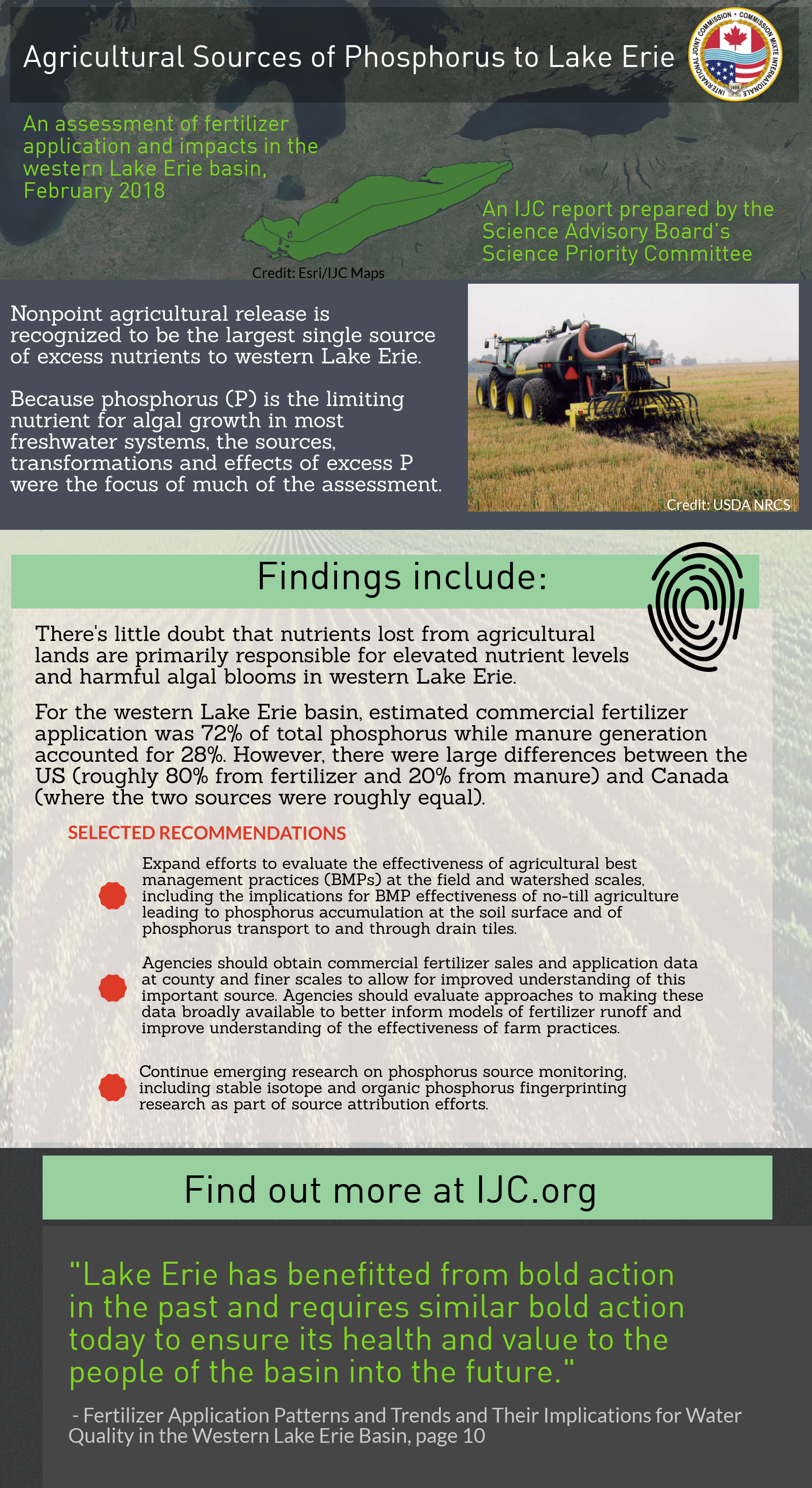Comprehensive assessment shows current and past agricultural fertilizer and manure applications are largest single source of excess phosphorus to western Lake Erie basin
Bold action needed to identify and implement management approaches to restore health of Lake Erie
In a report released today by the International Joint Commission titled Fertilizer Application Patterns and Trends and Their Implications for Water Quality in the Western Lake Erie Basin, an extensive analysis of existing data leaves little doubt that commercial fertilizer and manure applications are the largest sources of excess phosphorus into the western basin of Lake Erie. The IJC Science Advisory Board’s Science Priority Committee completed the assessment to better understand the influence of past, current and possible future nonpoint agricultural runoff of phosphorus into western Lake Erie, and their potential to cause eutrophic conditions and nuisance and harmful algal blooms (HABs). The area studied included the lake’s binational western basin as well as the St. Clair-Detroit River system, which feeds directly into Lake Erie.
Commercial fertilizer is the primary source of phosphorus from agricultural sources into the western basin overall and in the United States, while in Canada manure and commercial fertilizer are relatively equal sources. Given that the most recent comparable binational data are from 2006-2007 and that there are no well-established methods for distinguishing phosphorus loads from fertilizer versus manure in the laboratory, more specific fertilizer sales and application data as well as manure generation and application data are needed to advance our understanding of specific agricultural sources.
The analysis also showed that excess phosphorus from fertilizer application that is stored in agricultural soils and nearby ditches, buffer zones and wetlands has the potential to contribute the nutrients for years or even decades. "Even a small 'leakage' of excess phosphorus may be sufficient to contribute to algal blooms," the report says. Fortunately, the study found that following a period of phosphorus accumulation in soils, since the 1980s fertilizer application at a watershed scale is roughly balanced by phosphorus removal in harvested crops.
The expansion of conservation tillage, such as no-till, correlates with the rise of phosphorus entering the lake, because the nutrient accumulates in the soil’s uppermost layer. The widespread use of subsurface artificial tile drains also may increase rates of phosphorus entering the lake. Thus, although both these practices have associated benefits, they may be important contributors to the development of HABs. Additional research and monitoring is needed to quantify both sources and to explore new approaches to these practices to reap the benefits intended without increasing nutrient inputs into Lake Erie.
Climate change is expected to influence the rate of phosphorus entering Lake Erie. Years of high precipitation and warmer water temperatures can result in larger discharges of phosphorus from agricultural lands and faster development of HABs, as well as longer recovery timeframes. Again, additional monitoring is needed to evaluate climate change impacts on nutrient inputs and to adapt management actions that will meet targets for nutrient reductions into the western lake basin.
Finally, the report notes that the management practices associated with phosphorus application – including timing, rates, and the equipment used – may have a bigger influence on phosphorus release from agricultural lands than the category of fertilizer (commercial fertilizer or manure). A review of the effectiveness of current management practices is needed, with the goal of developing new approaches to more effectively reduce the input of phosphorus into the lake from fertilizer and manure applications. The 4R nutrient management program for fertilizer application should be expanded and evaluated for its effectiveness in order to develop new approaches.
"Phosphorus control measures enacted in the 1970s demonstrated that Lake Erie eutrophication could be reversed," the report states. "The challenge this time is with agricultural nonpoint sources of nutrients, which will require a different set of responses. Lake Erie has benefitted from bold action in the past and requires similar bold action today to ensure its health and value to the people of the basin into the future."
As a binational organization created by Canada and the United States under the Boundary Waters Treaty of 1909, the International Joint Commission serves as an independent assessor of the progress made by the two governments to achieve the objectives of the Great Lakes Water Quality Agreement.
For more information, see the full report. An infographic with highlights from the report is below.
PowerPoint presentation slides from report release webinar: download as pdf
Webinar video
For more information:
Sally Cole-Misch
Windsor
519-257-6733
Sarah Lobrichon
Ottawa
613-922-5368
Frank Bevacqua
Washington
202-736-9024
